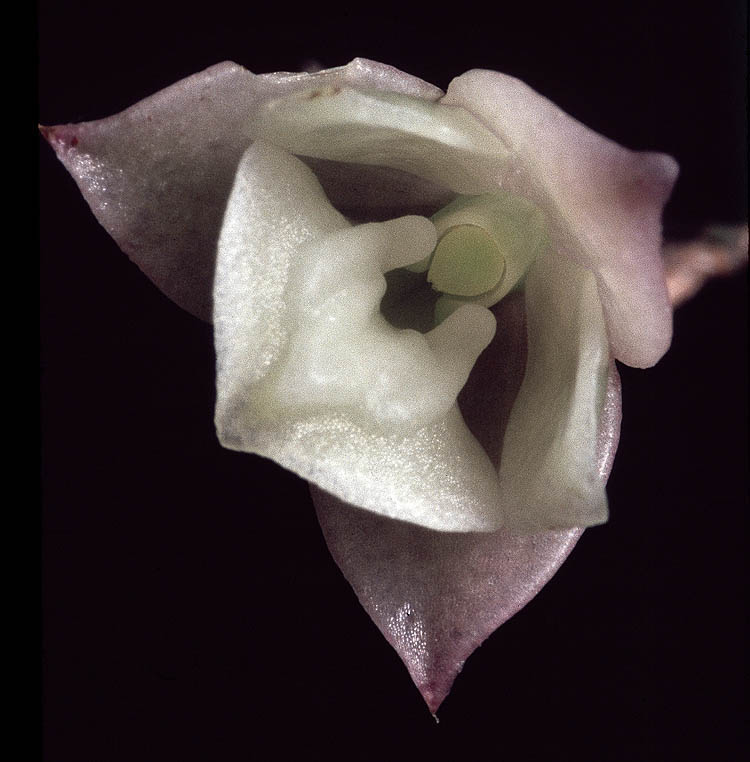

Epidendrum magnicallosum C.Schweinf. 1943 GROUP Physinga
Photo by © Gustavo A. Romero and LAS ORQUIDEAS DE LA CARRETERA YAVITA-MAROA THE ORCHIDS OF THE YAVITA-MAROA ROAD Website
TYPE Drawing by © Gordon W. Dillon
TYPE Drawing by © R Jimenez and The AMO Herbario Websiate



Common Name The Long Callus Epidendrum
Flower Size .8" [2 cm]
Found in Venezuela, Brazil and Peru in white sand scrub and shrub savannahs at elevations of 50 to 200 meters as a small sized, pendant to horizontally spreading, hot growing, shade loving epiphyte with simple, cane-like, terete at base, somewhat laterally compressed above, thin, stems concealed by tubular, smooth, evanescent with time, imbricating sheaths and carrying a single, apical, linear-lanceolate, purple-lavenderish dorsally, acuminate apically, abruptly conduplicate below leaf that blooms in the fall on a sub-erect to arching, solitary, terminal, flexuous, scapose, paniculate, 6 to 24" [15 to 60 cm] long, 2 to 3, shortly fractiflex branched towards the apex, successively single, to 6 flowered inflorescence enveloped by imbricating, elongate, tubular, acuminate spreading bracts with much shorter than the ovary, ovate, acute, somewhat tubular at base minute floral bracts and carrying sub-campanulate flowers with the sepals pale pink, petals and lip white, column and anther pale green; fragrance lacking.
"Epidendrum magnicallosum belongs to the GROUP Physinga which is characterized by to the generally small, caespitose plants, the inflorescence apical and racemose producing new racemes with time and thus pluri-racemose, the successive flowers opening one at a time on an elongate peduncle with acuminate bracts, the lip entire and the ovary with a prominent vesicle. The species is recognized by the thin stem 4.44 to 6.52" x .04 to .12" [11.1 to 16.3 x 0.1 to 0.3 cm], with a single apical leaf, linear-lanceolate, acute, coriaceous, 3.2 to 8.2 x .32 to .48" [8 to 20.5 x 0.8 to 1.2 cm], inflorescence 4 to 11.4" [10 to 27.7 cm] long, peduncle thin, producing new racemes from subapical internodes with time, flowers campanulate, pale pink with petals and lip white, sepals .276 to .3" [6.9 to 7.5 mm] long, lip .216 to .24" x .236 to .32" [5.4 to 6.0 x 5.9 to 8.0 mm], entire, sub-orbicular-obovate, base somewhat cuneate, apex truncate, apiculate in the wide apical sinus, margins entire, spreading; bicallose, the calli prominent, upright, forming a channel as wide as the entrance of the nectary, disc thickened and sulcate, formed by a narrow channel with an additional rib on each side, in front of the calli, and ending in a thickened mid-rib which nearly reaches the apical sinus. Epidendrum cystosum Ames has 3 to 6 leaves distributed through the stem, and a short inflorescence .6 to 1.8" [1.5 to 4.5 cm] long, lip sub-orbicular, sub-acute, .2 x .2" [5 x 5 mm], bicallose, and 5 narrow ribs on the disc. Epidendrum ceticaudatum Rinc.-González, Villanueva & E.Santiago, has 4 to 8 leaves distributed along the apical half of the stem, a long inflorescence .6 to .88" [15 to 22 mm] long, peduncle zig-zag with large flowers, sepals .52" [13 mm] long, pink, a white lip .24 to .36" [6 x 9 mm], convex, bicallose, with 3 ribs, shaped like the tail of a whale. Epidendrum hellerianum A.D.Hawkes is 12 to 20" [30 to 50 cm] tall, with 5 to 7 leaves, inflorescence zig-zag, sepals 1 to 1.2" [25 to 30 mm] long, and lip 3-lobed, apex deflexed." Hagsater etal 2019
Synonyms Encyclia magnicallosa (C.Schweinf.) Pabst 1967 publ. 1972
References W3 Tropicos, Kew Monocot list , IPNI ; Orchids of Peru Vol 2 Fieldiana Schweinfurth 1959 drawing fide; Orchidaceae Brasilense Band 1 Pabst & Dungs 1975 drawing good; Orchids of Venezuela, An Illustrated Field Guide Vol 1 Dunsterville & Garay 1979 drawing fide; Icones Orchidacearum Peruviarum Plate 244 Bennett & Christenson 1995 drawing fide; Orchids of Venezuela [An illustrated field guide] Vol. 1 Ramiro and Carnevali 2000 drawing fide; Flora of the Venezuelan Guayana Vol 7 Steyermark, Berry, Yatskievych and Holst 2003; Orquideas, Tesoro de Colombia Vol 2 Ortiz & Uribe 2017 photo fide; Icones Orchidacearum 17(1) Plate 1734 Hagsater & Jimenez 2019 drawing fide; Icones Orchidacearum 17(1) Plate 1792 Hagsater & Jimenez 2019 see recognition section;
--------------------------------------------------------------------------------------------------------------------------